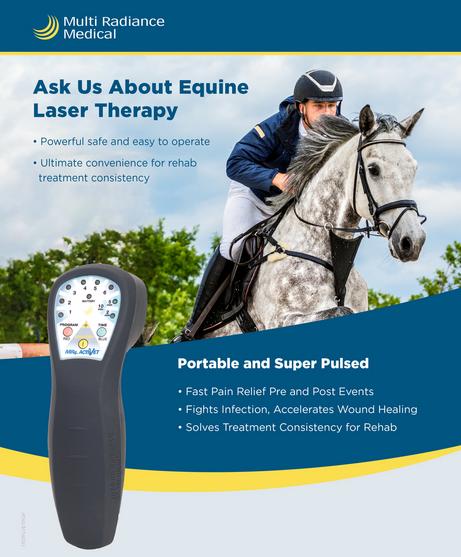Exploring the Holistic Strategy of Equine Therapy for Personal Development
Exploring the Holistic Strategy of Equine Therapy for Personal Development
Blog Article
Laser Treatment in Equine Therapy: A Modern Method to Improving Horse Wellness
Laser therapy has arised as a critical strategy in equine treatment, utilizing focused light energy to promote cellular fixing and expedite healing from a variety of conditions. This non-invasive approach is specifically effective in taking care of musculoskeletal injuries, wounds, and inflammatory problems, considerably boosting overall steed health. By promoting mitochondrial task and increasing ATP production, laser therapy not just improves flow yet likewise gives substantial discomfort alleviation. As this ingenious therapy remains to acquire grip, it opens up intriguing possibilities for resolving chronic conditions like joint inflammation and unguis problems, indicating a transformative change in vet care. What makes this technique especially compelling?
Understanding Laser Therapy
Laser therapy, a non-invasive treatment modality, has acquired significant traction in equine medicine due to its efficacy in promoting healing and discomfort alleviation. This innovative healing strategy uses focused light energy to penetrate tissues, cultivating mobile fixing and regrowth. The underlying system includes the excitement of mobile mitochondria, resulting in increased manufacturing of adenosine triphosphate (ATP), the power money of cells. Boosted ATP degrees expedite tissue repair service procedures and decrease inflammation, making laser therapy specifically reliable for dealing with musculoskeletal injuries, wounds, and various other inflammatory conditions in horses.
There are several sorts of lasers used in equine treatment, each with particular wavelengths and power outputs customized to various restorative needs. Low-level laser therapy (LLLT), also referred to as cold laser treatment, employs reduced power levels to promote cell feature without triggering thermal damages. High-intensity laser therapy (HANDLE), on the other hand, makes use of higher power degrees to attain deeper tissue infiltration and more considerable healing impacts.
Veterinarians make use of various laser gadgets and techniques depending upon the problem being dealt with and the preferred deepness of tissue infiltration. Correct training and expertise are critical for ensuring the risk-free and reliable application of laser therapy, thus optimizing its healing possibility while lessening threats.
Benefits for Horse Health
With a solid understanding of how laser treatment works, it is vital to explore its various benefits for equine health and wellness. One of the main advantages is its capacity to increase cells repair and cell development. By boosting mobile feature, laser treatment promotes faster wound healing and aids in the regeneration of broken cells. This can be especially helpful in lowering recuperation times for equines dealing with injuries.
Moreover, laser treatment has actually been shown to boost blood circulation, thus improving blood circulation to influenced locations. Improved circulation makes certain that necessary nutrients and oxygen are provided more successfully, promoting the healing procedure. Furthermore, laser therapy's anti-inflammatory results assist in reducing swelling and pain, which is important for the overall wellness of the horse.
Discomfort administration is another considerable benefit. By launching endorphins and blocking pain signals, laser treatment offers reliable, non-invasive remedy for both severe and chronic discomfort. This can contribute to enhanced mobility and high quality of life for the animal.
Finally, laser treatment is a non-invasive treatment choice, lessening the risk of issues associated with even more intrusive procedures. Its adaptability and efficacy make it an indispensable tool in modern-day horse vet medicine.
Typical Problems Dealt With

Another prevalent condition treated with laser therapy is joint inflammation. Steeds dealing with both intense and persistent joint inflammation take advantage of the anti-inflammatory results of laser therapy, which assists to ease discomfort and boost joint feature. Furthermore, laser therapy is utilized in the management of wounds. Whether dealing with medical lacerations or stressful injuries, the technique advertises quicker tissue repair visit site and reduces the threat of infection.
Horse respiratory problems, such as recurrent respiratory tract blockage (RAO), also react favorably to laser treatment. Laser treatment is helpful in treating hoof problems, including laminitis and abscesses.
Procedure and Security
Executing laser treatment in equine treatment includes a thorough procedure to make certain both effectiveness and security. Equine Therapy. The process begins with a comprehensive vet assessment to identify the viability of laser therapy for the equine's specific problem. When regarded suitable, the treatment location is prepared by cleansing and, if required, clipping the hair to improve laser infiltration
The practitioner has to select the appropriate kind of laser, generally a low-level laser (LLLT) or a high-power laser (HPL), depending upon the problem being dealt with. The laser tool is then calibrated to the suitable wavelength, power, and period setups. During the application, the specialist moves the laser over the targeted area in an organized fashion, ensuring consistent and even exposure.
Security procedures are purely complied with, consisting of using safety glasses for both the practitioner and the horse. Additionally, it is critical to keep an eye on the equine for any kind of signs of pain or negative responses throughout the treatment. Post-treatment, the equine is commonly offered a duration of remainder to enable the restorative impacts to manifest.

Future of Equine Laser Therapy
As innovations in vet medication continue to unravel, the click to investigate future of equine laser treatment holds substantial promise. Arising innovations and much deeper scientific understandings are set to fine-tune and increase the applications of laser therapy for steeds.
Furthermore, recurring research into the molecular and cellular systems of laser treatment will likely yield enhanced methods tailored to certain problems, improving efficiency and reducing treatment times. Personalized treatment strategies based upon hereditary and biochemical markers might come to be a reality, making sure that each steed receives one of the most proper and reliable care.
Additionally, governing advancements and standardization of protocols will improve the credibility and reliability of laser therapy in equine practice. Equine Therapy. As these developments remain to arise, equine laser treatment is positioned to come to be an essential element of veterinary care, offering improved recovery and improved quality of life for horses worldwide
Final Thought

Report this page